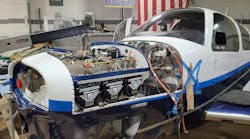The lingering effects of the pandemic continuing to be felt on the supply chain, affecting parts and aftermarket availability. These struggles are causing ripples across the industry, with trends quickly folding and unfolding as time moves on.
In the teardown market, Ben Hockenberg, president of JSSI Parts and Leasing, said growth has slowed due to in-service aircraft price increases, making it more difficult to justify the business case for teardowns.
“Between 2020 and 2021, this was evidenced by a 50% decrease in aircraft teardowns. Higher values and lack of quality assets have motivated owners to proceed with engine and airframe maintenance which previously would not have been undertaken. As a result, aircraft retirements have been pushed out,” Ben Hockenberg
Hockenberg added that since the shift, there has been prolonged strain on the procurement and supply chain.
“This isn’t just due to the lack of teardowns,” he continued, “but is also because of increased flight hour demands since July 2021. As a result, we are seeing heightened consumption of parts which is placing pressure on the availability of both used-serviceable and new parts.”
For the engine aftermarket, Kevin Lenz, senior vice president of power plants for AvAir, said there are several sides to the trends that he has been seeing.
“From an economics and activity standpoint, we're seeing service engine trading values up in general. There are more people, more money in the market comfortable reinvesting, or investing again, I should say, in space. It's created more competition. I think a lot of people are here to get back to trading activities. Some of the numbers we're seeing seem like they're commanding pricing on serviceable assets higher than we expected for this part of the cycle. It's all a good thing though, that means there's more activity, there's more demand for lift, and people are out and trading again,” Lenz said.
From a lease rate stand point, Lenz reports they're still coming back. There's still a lot of competitive leases out there which were driven by the pandemic and the discounts it was taking to lease assets when there wasn't as much activity.
“We're seeing asset prices rebound quicker than leasing, but we're seeing lease prices and certain models approaching pre-pandemic levels. There's a lot to it there from a trading standpoint. A lot of the airlines are still looking at swapping out their own engines to maximize every bit of green time that they can and keep their spends down,” Lenz said.
When an engine is put in for maintenance, a lease engine is installed in the aircraft so the operator can minimize downtime, added Hockenberg and, "As a result of labor and parts shortages, MROs are experiencing elongated turnaround times for engine maintenance. This means that lease engines are staying on aircraft longer and the knock-on effect is that there are fewer lease engines available.”
For many shops, Lenz says they are continuing to ramp up from the standstill of the pandemic.
“We saw the engine that we focus on the wide body side, PW 4,000 and CF 680, we saw pretty constants. We didn't see as much of a drop off in material demand from the shops, which we felt that the shops stayed pretty busy through the pandemic. That's easily explained by the demand for those engines in the cargo space. We're still seeing they're hungry as ever for material, meaning there's a lot of shop visits coming through. On the narrow body side, CFM56, 5B70, and the 2,500 for CM, a lot of that activity is picking up as well. Things seem to be trending in the right direction, really on both sides, as far as the engine that we focus,” he said.
However, we are still some ways out from normal.
Lenz said there are, "Supply chain constraints globally. In most industries we're seeing a big squeeze on that."
“It is fair to say that last year and the first half of 2022 have kept MROs very busy. One of the biggest challenges faced by MROs across the globe has been keeping work moving through workshops, despite labor and parts constraints. This, combined with increased utilization and a rise in unprecedented maintenance events, has created additional pressures throughout the entire MRO ecosystem, creating a domino effect of increased turnaround and AOG times,” said Hockenberg.
When getting material through engine shops, where certain component repairs used to take, 30 or 45 days we're seeing 90 to 120 day lead times from shops, Lenz noted.
“This puts a constraint. This is for component repairs so material you might need for an engine build or supply to an MRO. It's a bit of a trickle down or trickle up effect, I guess, depending on how you look at it, with it causing delays at engine shops as well,” added Lenz.
Hockenberg adds that unless there is an economic downturn that triggers a significant reduction in business flight utilization, demand for aircraft parts is not going to decrease any time soon.
“This will mean continued pressure on the supply chain and subsequent parts provision for the foreseeable future,” Hockenberg said.
“I think we're going to see much of the same, from the component side, and bottlenecks at repair shops,” said Lenz. “I think that's going to continue well into next year and hopefully be something that's sorted out, maybe late next year. Hopefully I'm wrong and things snap back more quickly, but I just don't see a quick fix there. The same with engine maintenance, I think the narrow body engine activity, MRO, is going to continue to pick up. The wide body, from what we focus on, has stayed relatively consistent and definitely strong right now.”
To weather the quick shifting tides of the post-pandemic world, Lenz advice is to take advantage of slot availability while you can.
“Any advice would be, be prudent to take a look at the schedule looking forward and potentially, if you can wrap your head around investing earlier than you absolutely need to, it might be a prudent thing to do,” he said.







